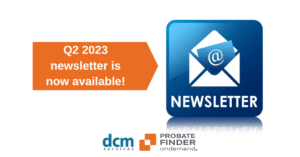By Matthew Rehnelt, Business Development Manager
As the American population continues its transition of the largest living adult generation from Baby Boomers to Millennials, many statistical differences between the two groups are coming to light. One particularly relevant aspect is the financial impact of the pandemic. A volatile housing market and increasing personal debts are creating a perfect storm for probate estates.
What’s happening?
It’s no secret that Millennials looking to become homeowners are having a tough time. In 2018, the Millennial home ownership rate was eight percent lower than Baby Boomers at the same age. Exaggerated effects caused by the pandemic have led to an increased demand for homes, an increased average home cost, and limited supply. By lacking the initial equity or liquid funds to compete against other buyers, this has resulted in approximately 52% of adults aged 18-34 moving back in with their parents. Numbers not seen since the great depression.
Seemingly related, online lenders are seeing a shift in how debts are being managed by each age group respectively. In 2020, LendingTree found that the Millennial and Gen Z generations were able to reduce their debts, while Baby Boomers have seen an average increase of almost $9,000. Contributing factors to the increase in Baby Boomer debt range from home renovation projects to unemployment.
The perfect storm
While long-term Millennial debt management habits remain to be seen, Baby Boomers have been consistently adding to their debt burden. From home renovation projects to increasing mortgage debt, trends show personal debt is growing for Baby Boomers while income is stagnating or even halted. Per the U.S. Census, by 2030, all Baby Boomers will be older than 65 and within that decade older adults will outnumber children for the first time in U.S. history. Mix in rising healthcare costs as the generation ages, more Baby Boomers are carrying larger amounts of debt when they pass away. The large average asset holdings and increasing personal debt have created a perfect storm for probate estates.
DCM Services (DCMS) has seen the number of open probate estates increase for the last several years, however the last two years have shown above average increases. Last year, DCMS Services’ proprietary probate database aggregated more than 507,000 new open probate estates; a 7 percent growth from 2019 and 79 percent growth from 2020. The large year-over-year jump is due to the resumption of probate court activities after operations were substantially restricted for the majority of 2020.
How organizations are adapting
These implications have left many organizations scrambling to try and capture what could be otherwise lost revenue by trying to pursue these remaining balances through probate. Organizations who successfully respond to this drastic change are automating their estate searching, utilizing data from multiple sources, and filing claims in timely fashion.
This is easier said than done as the identification of probate estates requires searching more than 3,200 counties. Accessibility varies greatly from county to county, and a majority require time intensive and costly methods such as telephone calls, written correspondence, and court required fees to search for a single name.
Even if your internal claim filing process generates revenue, manually searching for open estates can often result in delays and missing open estates altogether. Additionally, many courts impose unique barriers such as text color, probate search fees, watermarks, weighted paper, or thousands of other requirements.
Patented Forte technology removes the administrative inefficiencies by performing automated, nationwide searches for new and old probate estates. Once an open estate is identified and correctly matched to a placed account, claim packages can be automatically created.
Can’t believe how easy it sounds? See Probate Finder OnDemand in action yourself, schedule a demo here →





